Lt. Michael P. Murphy (SEAL) |
|
(1976-2005) |
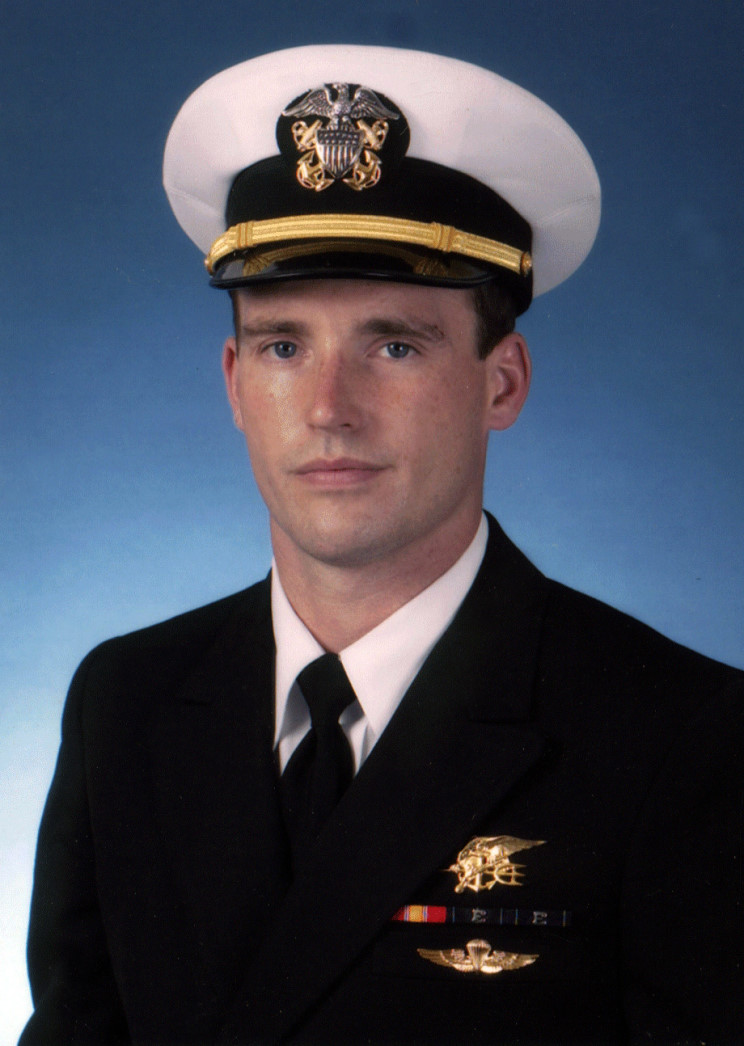 |
Lieutenant Michael P. Murphy United States Navy (SEAL) May 7, 1976 - June 28, 2005 |
Medal of Honor Citation |
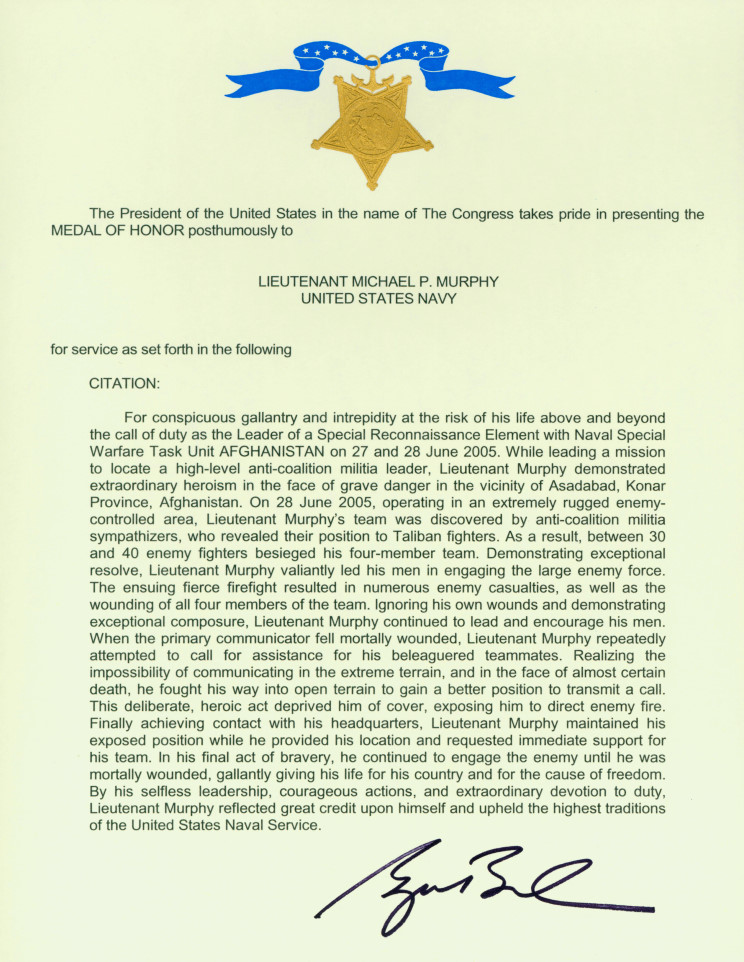 |
Lt. Michael P. Murphy, fondly referred to by friends and family as "Murph," was born May 7, 1976 in Smithtown, N.Y. and grew up in the New York City commuter town of Patchogue, N.Y. on Long Island. Murphy grew up active in sports and attended Patchogue's Saxton Middle School. In high school, Murphy took a summer lifeguard job at the Brookhaven town beach in Lake Ronkonkoma -- a job he returned to each summer through his college years. Murphy graduated from Patchogue-Medford High School in 1994. Murphy attended Penn State University, where he was an exceptional all-around athlete and student, excelling at ice hockey and graduating with honors. He was an avid reader; his reading tastes ranged from the Greek historian Herodotus to Tolstoy's "War and Peace." Murphy's favorite book was Steven Pressfield's "Gates of Fire," about the Spartan stand at Thermopylae. In 1998, he graduated with a pair of Bachelor of Arts degrees from Penn State -- in political science and psychology. Following graduation, he was accepted to several law schools, but instead he changed course. Slightly built at 5 feet 10 inches, Murphy decided to attend SEAL mentoring sessions at the U.S. Merchant Marine Academy at Kings Point with his sights on becoming a U.S. Navy SEAL. Murphy accepted an appointment to the Navy's Officer Candidate School at Pensacola, Fla., in September, 2000. Murphy was commissioned as an ensign in the Navy on Dec. 13, 2000, and began Basic Underwater Demolition/SEAL (BUD/S) training in Coronado, Calif., in January 2001, graduating with Class 236. BUD/S is a six-month training course and the first step to becoming a Navy SEAL. Upon graduation from BUD/S, he attended the Army Jump School, SEAL Qualification Training and SEAL Delivery Vehicle (SDV) school. Lt. Murphy earned his SEAL Trident and checked on board SDV Team (SDVT) 1 in Pearl Harbor, Hawaii in July of 2002. In October of 2002, he deployed with Foxtrot Platoon to Jordan as the liaison officer for Exercise Early Victor. Following his tour with SDVT-1, Lt. Murphy was assigned to Special Operations Central Command in Florida and deployed to Qatar in support of Operation Iraqi Freedom. After returning from Qatar, Lt. Murphy was deployed to the Horn of Africa, Djibouti, to assist in the operational planning of future SDV missions. In early 2005, Murphy was assigned to SEAL Delivery Vehicle Team 1 as assistant officer in charge of ALFA Platoon and deployed to Afghanistan in support of Operation Enduring Freedom. On June 28, 2005, Lt. Murphy was the officer-in-charge of a four-man SEAL element in support of Operation Red Wing tasked with finding key anti-coalition militia commander near Asadabad, Afghanistan. Shortly after inserting into the objective area, the SEALs were spotted by three goat herders who were initially detained and then released. It is believed the goat herders immediately reported the SEALs' presence to Taliban fighters. A fierce gun battle ensued on the steep face of the mountain between the SEALs and a much larger enemy force. Despite the intensity of the firefight and suffering grave gunshot wounds himself, Murphy is credited with risking his own life to save the lives of his teammates. Murphy, intent on making contact with headquarters, but realizing this would be impossible in the extreme terrain where they were fighting, unhesitatingly and with complete disregard for his own life moved into the open, where he could gain a better position to transmit a call to get help for his men. Moving away from the protective mountain rocks, he knowingly exposed himself to increased enemy gunfire. This deliberate and heroic act deprived him of cover and made him a target for the enemy. While continuing to be fired upon, Murphy made contact with the SOF Quick Reaction Force at Bagram Air Base and requested assistance. He calmly provided his unit's location and the size of the enemy force while requesting immediate support for his team. At one point, he was shot in the back causing him to drop the transmitter. Murphy picked it back up, completed the call and continued firing at the enemy who was closing in. Severely wounded, Lt. Murphy returned to his cover position with his men and continued the battle. As a result of Murphy's call, an MH-47 Chinook helicopter, with eight additional SEALs and eight Army Night Stalkers aboard, was sent in as part of the QRF to extract the four embattled SEALs. As the Chinook drew nearer to the fight, a rocket-propelled grenade hit the helicopter, causing it to crash and killing all 16 men aboard. On the ground and nearly out of ammunition, the four SEALs, continued to fight. By the end of a two-hour gunfight that careened through the hills and over cliffs, Murphy, Gunner's Mate 2nd Class (SEAL) Danny Dietz and Sonar Technician 2nd Class (SEAL) Matthew Axelson had fallen. An estimated 35 Taliban were also dead. The fourth SEAL, Hospital Corpsman 2nd Class (SEAL) Marcus Luttrell, was blasted over a ridge by a rocket-propelled grenade and knocked unconscious. Though severely wounded, the fourth SEAL and sole survivor, Luttrell, was able to evade the enemy for nearly a day; after which local nationals came to his aide, carrying him to a nearby village where they kept him for three more days. Luttrell was rescued by U.S. Forces on July 2, 2005. By his undaunted courage, intrepid fighting spirit and inspirational devotion to his men in the face of certain death, Lt. Murphy was able to relay the position of his unit, an act that ultimately led to the rescue of Luttrell and the recovery of the remains of the three who were killed in the battle. Lt. Murphy was buried at Calverton National Cemetery less than 20 miles from his childhood home. Lt. Murphy's other personal awards include the Purple Heart, Combat Action Ribbon, the Joint Service Commendation Medal, the Navy and Marine Corps Commendation Medal, Afghanistan Campaign Ribbon and National Defense Service Medal. Lt. Murphy is survived by his mother Maureen Murphy; his father Dan Murphy; and his brother John Murphy. Dan and Maureen Murphy, who were divorced in 1999, remain close friends and continue to live in N.Y. Their son John, 22, attends the New York Institute of Technology, and upon graduation will pursue a career in criminal justice, having been accepted to the New York City Police Deparment. |
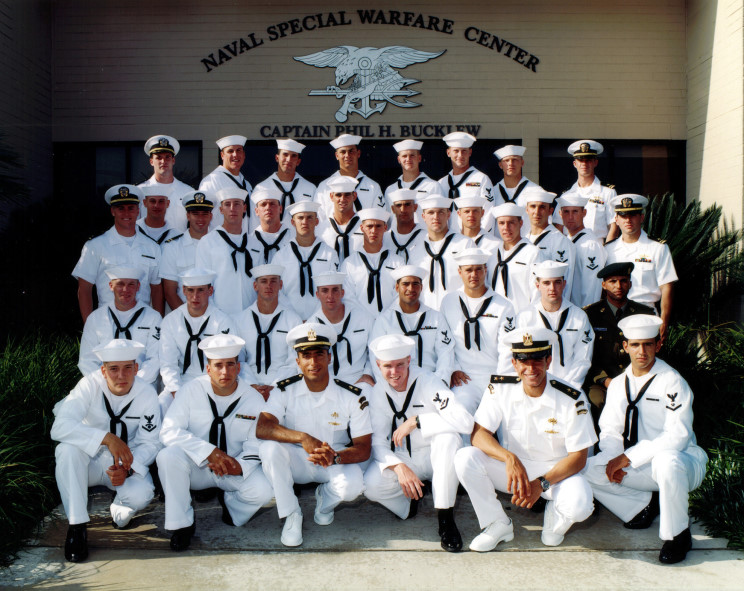 |
October 19, 2001: Basic Underwater Demolition/SEAL (BUD/S) graduating class 236. Navy SEAL Lieutenant Michael P. Murphy, 29, is pictured on the far left side of the back row. |
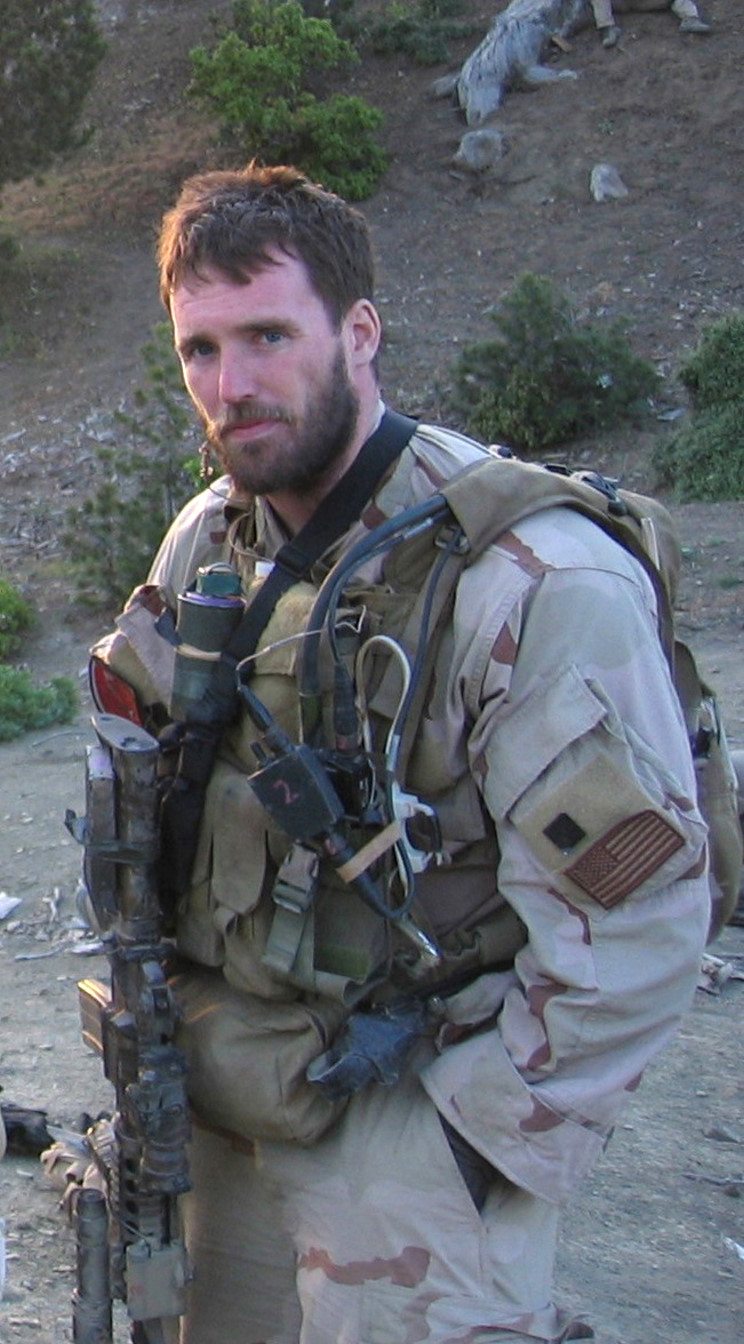 |
Lt. Michael P. Murphy (SEAL) seen during deployment in Afghanistan.
|
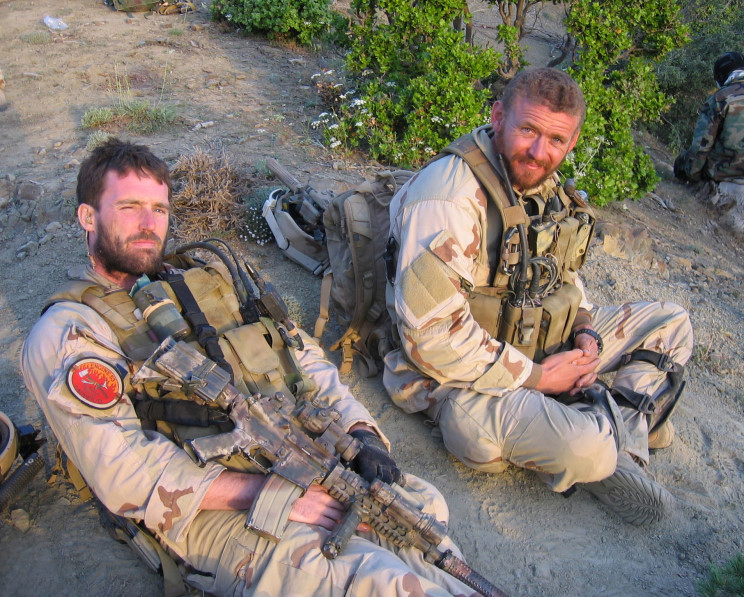 |
Lt. Michael P. Murphy (SEAL) and Sonar Technician (Surface) 2nd Class Matthew G. Axelson seen on depoyment in Afghanistan.
|
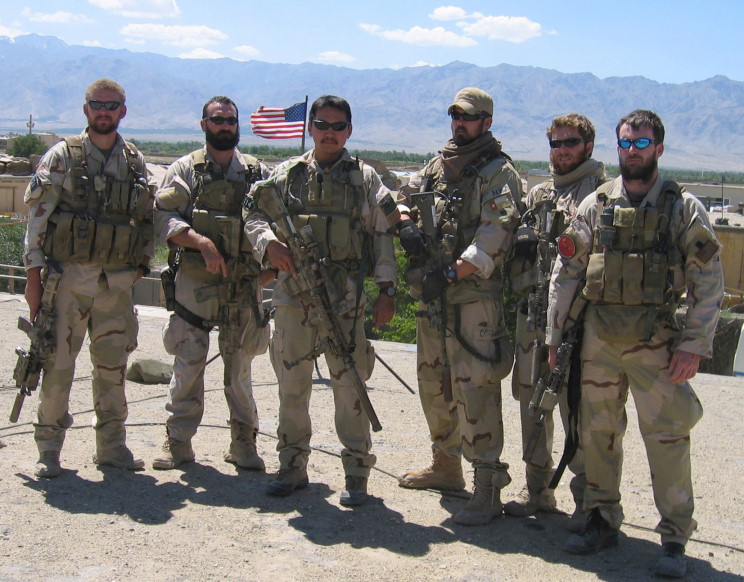 |
Navy SEALs operating in Afghanistan in support of Operation Enduring Freedom. From left to right, Sonar Technician (Surface) 2nd Class Matthew G. Axelson, Senior Chief Information Systems Technician Daniel R. Healy, of Exeter, Quartermaster 2nd Class James Suh, Hospital Corpsman 2nd Class Marcus Luttrell, Machinist's Mate 2nd Class Eric S. Patton and Lt. Michael P. Murphy. |
Operation Redwing June 28, 2005 |
On June 28, 2005, deep behind enemy lines east of Asadabad in the Hindu Kush of Afghanistan, a very committed four-man Navy SEAL team was conducting a reconnaissance mission at the unforgiving altitude of approximately 10,000 feet. The SEALs, Lt. Michael Murphy, Gunner's Mate 2nd Class (SEAL) Danny Dietz, Sonar Technician 2nd Class (SEAL) Matthew Axelson and Hospital Corpsman 2nd Class (SEAL) Marcus Luttrell had a vital task. The four SEALs were scouting Ahmad Shah - a terrorist in his mid-30s who grew up in the adjacent mountains just to the south. -NSW- OPERATION REDWING KIAs- On June 28, 2005, three of four SEALS on the ground (Murphy, Dietz, Axelson) were killed during combat operations in support of Operation Red Wing. ON the same say, a QRF of eight Navy SEALs and 8 Army Night Stalkers were also killed when the MH-47 helicopter that they were aboard was shot down by enemy fire in the vicinity of Asadabad, Afghanistan in Kumar Province. Navy SEALs
SEAL Delivery Vehicle Team 2, Virginia Beach, Va.
SEAL Team 10, Virginia Beach, Va.
Army Night Stalkers
HQ Company, 160th Special Operations Aviation Regiment (Airborne), Fort Campbell, Ky.
U.S. Navy SEALs are the maritime component of U.S. Special Operations Command and the Navy's special operations force. The SEALs take their name from the elements in which they operate - sea, air and land. Experts in special reconnaissance and direct action missions - SEALs continue to successfully execute DoD's most important warfighting missions in the GWOT. |
President Bush Presents Medal of Honor to Parents of Navy SEAL |
10/22/2007 By John J. Kruzel, American Forces Press Service WASHINGTON (NNS) -- President Bush today posthumously presented the Medal of Honor earned by Lt. Michael P. Murphy, a Navy SEAL who sacrificed his life in an attempt to save fellow SEALs during a fierce battle with Taliban fighters in Afghanistan. The Medal of Honor, accepted by Murphy's parents, Maureen and Dan Murphy, during a White House ceremony, is the highest military decoration. Murphy's is the first Medal of Honor awarded for service in Operation Enduring Freedom in Afghanistan. "Today we add Lieutenant Michael Murphy's name to the list of recipients who have made the ultimate sacrifice," Bush said. "By presenting Michael Murphy's family with the Medal of Honor that he earned, a grateful nation remembers the courage of this proud Navy SEAL." On June 28, 2005, as Murphy led a four-man SEAL team in search of key terrorist commander, the unit came under attack by some 50 Taliban fighters. The lieutenant is credited with risking his own life to save the lives of his teammates, according to a summary of action published by the Navy. Despite intense combat around him, Murphy -- already wounded in the firefight -- moved into the open where he could gain a better transmission signal and request backup from headquarters. At one point, Murphy was shot in the back, causing him to drop the transmitter. The lieutenant picked it back up, completed the call and continued firing at the enemy as they closed in. By the time the two-hour gunfight had concluded, Murphy and two others SEALs had been killed. An estimated 35 Taliban died in the fighting. As a somber postscript to Murphy's bravery, the helicopter that he requested crashed after being struck by a rocket- propelled grenade, killing everyone on board. In total, 19 Americans died in what Bush referred to as "the deadliest for Navy Special Warfare forces since World War II." The president characterized Murphy as a born Navy SEAL. "SEALs get their name from operating by sea, air and land, and even as a toddler, Michael could find his way through any obstacle," Bush said. "When he was just 18 months old, he darted across a neighbor's yard and dove into the swimming pool. By the time his frantic parents reached him, Michael had swum to the other side with a big smile on his face." In addition to his physical strength, Bush said Murphy's strong moral character also was apparent at an early age. "One day in school, he got into a scuffle sticking up for a student with a disability. It's the only time his parents ever got a phone call from the principal, and they couldn't have been prouder," Bush said. "Michael's passion for helping others led him to become a caring brother, a tutor, a life guard and eventually a member of the United States armed forces." The president welcomed Murphy's parents and brother, John, who hail from Patchogue, N.Y., to the White House's East Room, noting that Murphy's decision to join the U.S. military was not easily accepted by his family. "As a Purple Heart recipient during Vietnam, Michael's father understood the sacrifices that accompany a life of service. He also understood that his son was prepared to make these sacrifices," Bush added. Murphy is remembered by fellow SEALs as a wisecracking friend who went by "Mikey" or "Murph," a patriot who wore a New York City firehouse patch on his uniform in honor of the heroes of 9/11, Bush said. "And they remember an officer who respected their opinions and led them with an understated yet unmistakable sense of command. Together Michael and his fellow SEALs deployed multiple times around the world in the war against the extremists and radicals," Bush said. "And while their missions were often carried out in secrecy, their love of country and devotion to each other was always clear." Murphy is one of three servicemembers to receive the Medal of Honor posthumously for gallantry in action during the war on terror. The president has presented medals to the families of Army Sgt. 1st Class Paul R. Smith and Marine Cpl. Jason L. Dunham, who died in Iraq. |
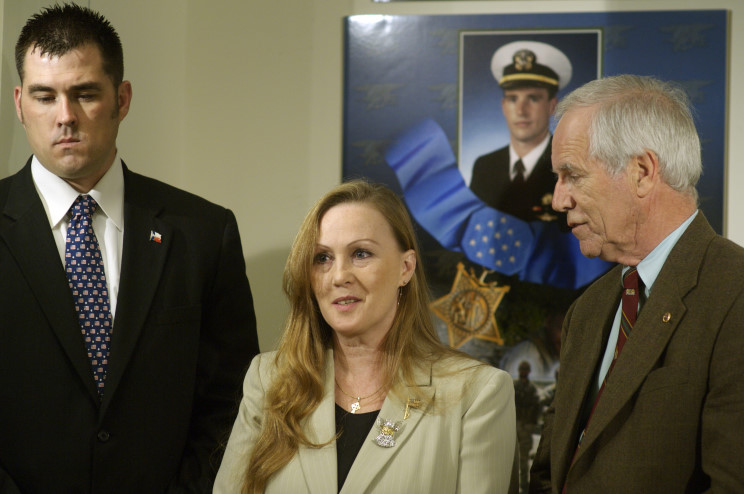 |
Navy SEAL Marcus Luttrell stands beside Daniel and Maureen Murphy, the parents of Navy SEAL Lt. Michael Murphy, as they are interviewed during a tour of the Pentagon. The family of Lt. Murphy toured the Pentagon before a ceremony to unveil Lt. Murphy's name in the Pentagon's Hall of Heroes. |
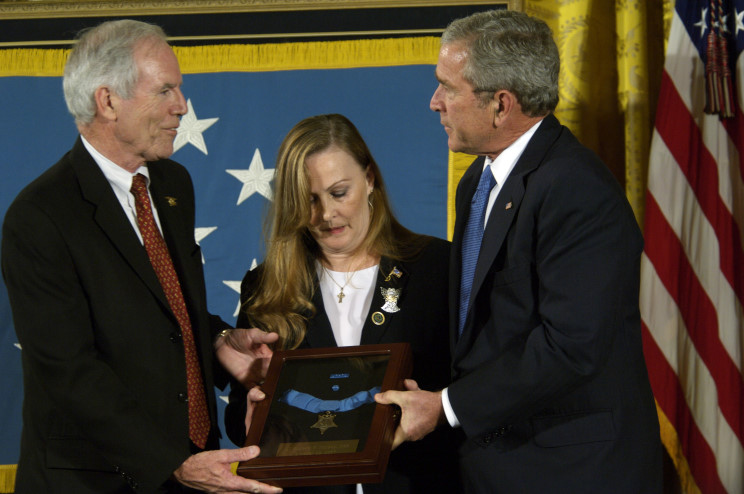 |
October 23, 2007: President George W. Bush presents the Medal of Honor to Daniel and Maureen Murphy, the parents of Navy SEAL Lt. Michael Murphy, during a ceremony at the White House. |
(All photos and text courtesy of the U.S. Navy) |
Page published Oct. 23, 2007 |